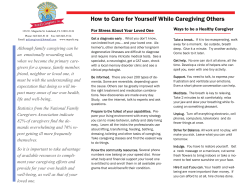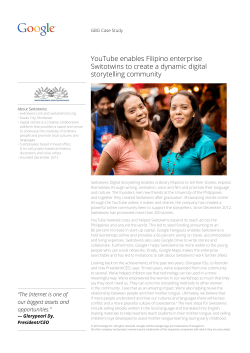
to see Simone Castello`s presentation on web display
Print to Web: Managing mul2-‐pla5orm display By Simone Castello Canadian Living magazine CanadianLiving.com April 16, 2015 What’s different about the web? While display in book can be fun, pithy and pun-ny, you have fewer chances to draw the reader’s attention online. You need to serve a purpose: How will this article/slide show help or engage the reader? Think about how your reader gets to you article. They pick up magazines, but they need to be directed to your piece of content online Fewer chances to get creative with how content is displayed online. What you need to keep in mind when transferring content online: - Has this piece been SEO’d? (**Most important one!) - Is it intuitive? (Can it be easily found through various sources?) - How can I promote this piece on my social media streams? What’s the hook? - How can I keep readers on my site? Example: Story from CL April 2015 MODERN FAMILIES More than half of Canadians are caring for children at home at the same time as their own parents start to ail. It’s exhausting, and the risk of burnout is real. Here’s how to cope. BY TRALEE PEARCE Know your motivation Caregiving isn’t an easy job, says Nira Rittenberg, an occupational therapist who runs support groups for the families of patients at Toronto’s Baycrest Health Sciences, a hospital focused on geriatric care. Ask yourself if you are helping or visiting your parent out of love or duty. Your answer will help you frame your journey and reduce any feelings of guilt. “Don’t torture yourself if you can’t conjure the same emotions or feelings,” she says. As Françoise Mathieu, director of Compassion Fatigue Solutions, a consulting firm in Kingston, Ont., puts it: “We weren’t all born to be Florence Nightingale. The caregiver role is often thrust upon us. Just because someone’s aging mother or father is ill doesn’t mean we had a healthy relationship with them in the past, or that they are nice or easy people to deal with.” Also, before you waste too much energy wondering why a sibling isn’t lifting a finger to help, accept the fact that not all family members will have the motivation you do. Rittenberg has told clients, in the context of sharing the caregiving, to think of themselves as only children—just go ahead and do your part. “Changing someone else along the way? It’s not going to happen.” THE FAMILY squeeze ou need an hour to finish that work report. You desperately need to do a grocery shop. It’s your turn to do the day-care pickup. Oh, and your mom really needs your help getting to a doctor’s appointment. Even the most organized member of the so-called sandwich generation can feel as though she’s coming up short in just about every race she’s running. A recent national survey found that 55 percent of Canadians aged 45 to 64 are juggling the care of children at home along with the increased demands of aging or ailing 0066_CL_Apr15 66 parents. And experts say that, despite the pressures, caregivers soldier on, putting their own health in danger. (Family caregivers of Alzheimer’s patients, for instance, suffer high rates of depression and significantly reduced immune function.) Are you feeling the squeeze? Here are a few fresh approaches. PHOTOGRAPHY, LAWREN/GETTY IMAGES y Do your research CANADIANLIVING.COM | APRIL 2015 2015-02-11 3:43 PM Educating yourself on your parent’s condition, whether it’s an illness or an issue related to old age and its effects on daily life is helpful, says Rittenberg. This can make uncomfortable visits less upsetting and inspire more realistic expectations for all. “It’s not such an easy task to reverse roles with a parent and also to suddenly be dealing with issues that are not typical to the relationship you knew.” To that end, you may learn that, as a dementia or dialysis patient, your parent may have more energy and be more alert for a visit at a specific time of day. Less can be more Many people overvisit parents with conditions such as dementia, says Rittenberg. Aim for short and focused rather than prolonged and tiring. “Don’t wait for the visit to deteriorate because of fatigue, illness or dwindling patience,” she says. Try APRIL 2015 | CANADIANLIVING.COM 0067_CL_Apr15 67 55% of Canadians aged 45 to 64 are juggling the care of children at home and aging or ailing parents. for more frequent half-hour pop-ins during the week instead of a marathon visit every weekend. Focus on an activity Rather than engaging in small talk, take a photo album or board game to connect over. Sharing a leisurely lunch or giving Mom a manicure may provide a more meaningful connection than running around getting groceries. If a loved one is mobility-impaired, a wheelchair-assisted outing to a museum may be less work— and more delightful—than keeping him or her entertained at home. And regardless of the activities you choose, ditch the smartphone and be present. Put yourself first Mathieu cringes at much of the generic self-care advice she’s heard, especially when she herself has been in a caregiving role. “Being told to eat more kale and do more yoga can be difficult to hear when pressed for time and overwhelmed with caregiving duties,” she says. Do what feels best for you to destress, like indulging in a favourite pastime. Or arrange a playdate for your children at a friend’s house to buy you a few hours to recharge. It’s OK to say no You simply can’t be in two places at once, so it is fine to say no to others placing demands on your time, says Karen Cleveland, etiquette expert in Toronto. “By being honest about your commitments and politely declining where you have to,” says Cleveland, “you gain not only precious time in your schedule but also some autonomy and the feeling that you’re driving your schedule, instead of vice versa.” Share and delegate responsibilities This one might be the toughest because it takes time to focus on how others might help. The family member who has no bedside manner can pick up the slack in ways other than caregiving, such as preparing meals. Your teens can mow the lawn. Out-of-town siblings can financially chip in for housecleaning or grocery-delivery services. Many caregivers rely on a shared online schedule, such as Google Calendar, to help them farm out medical appointments, chores and visits and to minimize phone tag. Bring backup Don’t dismiss the possibility that your friend who makes the mean casserole may also be great as a special guest at the nursing home or hospital, says Rittenberg. She’ll have new stories for your loved one and can allow you to play second fiddle. And because she’s less invested emotionally, she’ll be less vulnerable to family dynamics and may actually lighten up any tension by being there. Reach out for help It’s possible to have moments you’re not proud of, like thinking, I wish Mom would eat faster, during a visit. “We can feel tremendous shame. But these thoughts are natural,” says Mathieu. When it’s a red flag: if you’re practising “subtle neglect,” such as leaving a loved one in a bath alone for a little too long or mocking him, or if you’re self-medicating the stress away with alcohol, pills or other crutches. “When you’re burned out, you may watch too many hours of Netflix or shop. We all know in our heart of hearts when it’s tipped over into numbing out.” Don’t be afraid to seek help. At Baycrest Health Sciences, for instance, there are therapists and social workers who specialize in the area of caregiver fatigue and can provide counselling, education and referrals to help alleviate burnout. Ask about support groups and other resources through community care networks or your province’s ministry of health, or visit resource sites such as Rittenberg’s compassionfatigue.ca. Remember, caregivers need care, too. 67 2015-02-11 3:43 PM BASIC SEO TOOLS: Or, how do people find my content? Use Google Adwords: A handy keyword planning tool that will help you gain insight into what your audience is looking for. All you need is a Gmail address to access this handy tool. Use Google Trends: Another handy tool courtesy of the folks at Google. You can see peak periods for par2cular trends: Spring nail polish colours? Best jobs in Canada? (People are always looking for chicken recipes…) Google Keywords: ‘sandwich genera2on’ and ‘balance work life’ Check out your headline op2ons on Google Trends: Or you can also try typing it into Google search: If it shows up a\er you type in three words, chances are people are looking for content like this. Story from CL April 2015: ONLINE More examples of how stories from in book appear online In book: March 2015 How this story appeared online In book: March 2015 How this story appeared online PARENTING The tween years are a time of push and pull. Here’s how to help maintain a strong relationship with your child while still supporting her developing autonomy. INDEPENDENCE movement A NYONE PARENTING A TWEEN KNOWS that nine- to 12-year-olds can be a challenging lot. Testing limits and pushing boundaries are what they seem to do best. “Tweens are undergoing biological changes that make them a hormonal cocktail,” says Toronto-based parenting coach Alyson Schafer. “They have one foot in childhood and one in adulthood. They can oscillate between spheres from day to day and at different moments.” While it’s a bit of a wild ride, it’s perfectly normal, says Schafer. “Tweens have the developmental task of trying to define themselves and to find acceptance with their peers. They will experiment with personae and dress codes and various friend groups.” This is all on top of fulfilling their growing need for independence while staying connected to their parents. As our tweens struggle to figure it all out, it’s important for parents to offer support and guidance along the way. 62 0062_CL_Feb15 62 PHOTOGRAPHY, VSTOCK LLC/TETRA IMAGES/CORBIS (GIRL); MASTERFILE (BOY) BY YUKI HAYASHI CANADIANLIVING.COM | FEBRUARY 2015 2014-12-03 9:35 AM In book: March 2015 How this story appeared online In summary: -‐ Think of how your content will reach your readers. What would you look for in search engines to find a piece like this? -‐ Think of your audience and niche. Cater to them. -‐ Save pithy for social media. Make SEO your first priority with display copy on your site. -‐ Use Google Adword and Trends to help develop your headline using appropriate keywords – modify your dek accordingly. -‐ Remember that search comes first.** -‐ Be nice to your art department and apologize to your print team for taking all the fun out of their catchy/award-‐winning headlines. J **Unless you’re BuzzFeed. In which case, viral comes first.
© Copyright 2025










